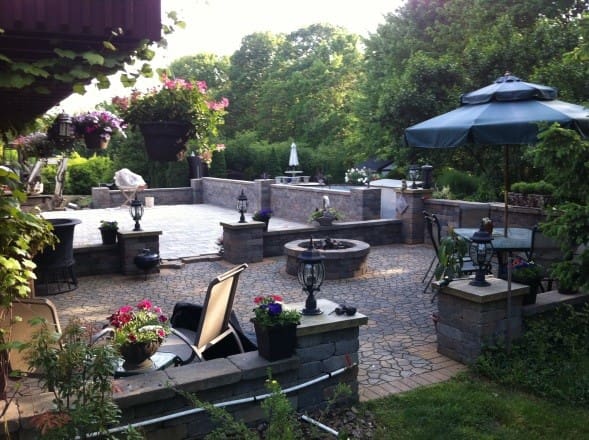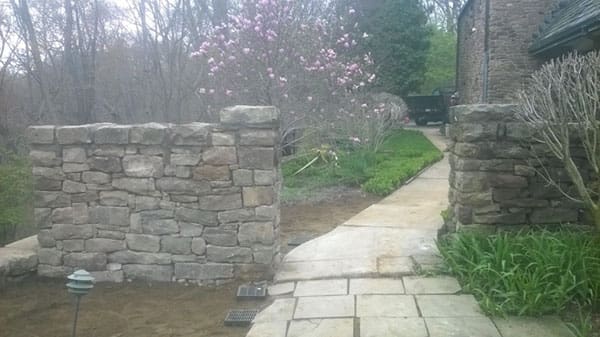Product Specifications
Retaining Wall Technical Specifications in Pittsburgh, PA
Retaining and Free Standing Walls
This simple and easy to follow Retaining Wall Technical Specifications bulletin is provided to help the homeowner learn and understand the basics of Hardscape wall construction details.
The decision to install a stone retaining wall in Pittsburgh, PA to enhance your yard needs to be carefully considered. There are many factors that have to be accounted for in the design. This technical specification addresses the basics of retaining wall construction design aspects. The overview will help the homeowner determine the type of wall needed as well as understand what design features must be incorporated into the plan. These design features will impact the cost of the stone retaining wall project.
There are many different types of hardscape walls, but they fall into two main categories: Free Standing and Retaining. Within these two classifications, there are: retaining, seating, privacy, and entrance way wall designs. Concurrent with these designs, there may be pillars, corners, tiers and stairs that need to be added to finalize the design. Lighting, water facilities as well as green landscaping will also be requirements that need to be looked at. Walls can be constructed from natural stone blocks (normally Barnstone, Limestone, Sandstone or Granite), brick veneer on concrete module units, concrete module units or what are commonly called segmented wall blocks, which are precast blocks designed to mimic various stone designs.
Retaining walls in Pittsburgh, PA can be constructed with many various techniques. Some are constructed with interlocking features, and are anchored into the landscape. Others may be mortared in place and anchored into the landscape while others may be dry stacked in place. In any case, wall construction techniques will be a function of the application and criteria that needs to be met to insure they are built safely and meet code.
Therefore, our advice is — “learn about the type of wall you need and want and take your time to make a decision”. — We encourage the homeowner to examine as many different layouts and choices as possible. Look through the Wichman social media sites noted on the last page as well as examine “Pins” on Pinterest and” Ideabooks or Projects” on Houzz. Pick up and examine as many of the various landscaping design booklets or browse through the various product design brochures offered by the manufacturers as well as offerings made by the landscape supply houses, to get a sense of what is available in the way of product choices. For your convenience, we have listed embedded sites to view within or at the end of the bulletin.
This technical bulletin addresses the basics of wall construction design features. It will help the homeowner plan the best layout that meets their needs and budget.
Retaining Walls
The first consideration is the placement of the wall and whether it is a free standing wall or it is a wall that will be used to retain and contain soil, landscape (as shown above) and / or a surcharge. Surcharge is normally referred to as the added weight above the wall in the form of a pool, patio or driveway. The length of the wall is not an issue normally (can be if water runoff is a problem), but the height of the wall will be the single most defining design aspect that will dictate construction details. Therefore, when first starting to scope out the project, consider these issues:
- Property Lot Lines. Your municipality will have copies of your lot survey on file. The survey will not only identify property lines but may provide a scaled template of your lot to help in the planning.
- Utilities. Buried utility lines such water, cable, electric and gas may prevent you from locating your wall project. Mark the lines, if you know where they are, or call your local utility to have them mark the lines. A good reference is to call PA 1 @ 811 or 1-800-242-1776. They will assist in helping you to verify incoming utility runs.
- Permits. Permits may be required if the retaining wall is above a certain height. Generally, in the Pittsburgh area, either a City code, Municipality or Borough code will advise desgin criteria for a retaining wall. Check to see what the local code is and whether or not you need an approved engineered wall design aligned with an elected supplier. There are different wall construction systems that can be considered. Wichman Landscape Construction can help you to determine, which wall retaining system would be appropriate
- Neighbors. Depending on the wall location and the proximity to neighboring properties, let your neighbors know about your project before you begin.
- Soil. One of the most important aspects of construction will be the type of soil the wall sits on as well as retains. Clay soils will place more pressure on a wall because they retain moisture while sandy soils will drain moisture. A good rule of thumb is to pick up the soil and using your hand squeeze it to form a ball. However, never use organic soil; it will not hold the pressure.
- Vegetation and Environmental Considerations. Shrubs, trees and other vegetation can be designed into the area above and supported by the retaining wall. However, care needs to be exercised not to disturb the support system that may be used to reinforce the wall.
- Wall Base or Foundation. A Retaining wall must be built on a secure foundation or footer. Wichman Landscape Construction can advise based upon soil conditions and placement, what type of foundation will need to be applied to support the wall.
- Determine the Wall Height. There are two types of wall construction techniques as well as different wall retaining systems that can be used to build the wall. The two basic designs are a gravity or a reinforced wall.
-
- Gravity walls rely on their own weight and setback to hold up the soil behind them.
- Reinforced walls rely on the use of Geogrid layers to combine the soil and the block to form a reinforced soil mass.
Normally, once a wall starts to exceed 3’ in height, design considerations become more pronounced. Soil type, slope and surcharge are now are the important issues that need to be evaluated. Wall set back and embedment depth of the base block now need to be reviewed as they will dictate how the wall will be constructed. There are many different types of retaining walls systems and Wichman is familiar with all those offered in the region. Two methods of construction are illustrated below in these links:
- Gravity Design by Redi-Rock:
- Reinforced Design by Versa-Lok © Standard designs:
Additional wall system manufacturers are listed at the end of this brochure.
Therefore, depending on the retaining wall system chosen, the height of the wall tiered or not with an offset and setback, as well as with or without surcharge, will affect the cost of the stone retaining wall. Using the planning guide at the end of the bulletin to develop the outline of your wall, discuss with Wichman Landscape Construction the overall design and they will advise on the best material choice and system to meet your stone retainign wall cost and layout needs.
Freestanding Walls
Free Standing walls are typically used in the following settings: courtyards, seating walls, entrance, privacy and landscape, planter and amphitheater type walls. In the pictures below, there are two types of Free Standing walls: Seating walls that are near the Fire Pit that afford comfort near the fire; and a privacy wall that separates the driveway from a pool area., or entrance way walls. Pillars are sized to match the wall in height.
A typical rule of thumb would be to consider that the height of a free standing wall is normally 3.75 times the base width. So if the base width is 24”, then the maximum height would be approximately 7’6”. If the base width was 12”, then the height with cap would be 42”. An 8” thick stone could yield a wall height or 4x or 36” with a cap. Wichman Landscape Construction can advise on further designs conditions. Shown below is a typical view of a free standing wall.
When first starting to scope out the project consider these issues:
- Property Lot lines. Your municipality will have copies of your lot survey on file. The survey will not only identify property lines but may provide a scaled template of your lot to help in the planning.
- Utilities. Buried utility lines such water, cable, electric and gas may prevent you from locating your wall project. Mark the lines, if you know where they are, or call your local utility to have them mark the lines.
- Permits. Permits may be required if the privacy wall is above a certain height. Check to see what the local code is and whether or not you need an approved engineered wall design aligned with an elected supplier. Free standing walls will have the height fixed as well, dependent on the block size and design chosen. Wichman Landscape Construction can help you to determine, which wall system to consider.
- Neighbors. Depending on the wall location and the proximity to neighboring properties, let your neighbors know about your project before you begin.
- Wall Base or Foundation. All Free Standing Walls must be built on a secure foundation or footer. Wichman Landscape Construction can advise based upon soil conditions and placement, what type of foundation will need to be applied to support the wall.
Planning Your Wall:
Retaining walls are heavy work and not a one man job. – They require someone that understands the construction and design of segmented retaining walls, equipment, knowledge of soils and a crew to set the units.
Use the following Wichman worksheet Grid technical sheet.pdf to help in the design of your project.
Please fill in the blanks to develop the wall design:
Height______________
Length______________
Tiered______________
Free Standing________
Pillar Spacing_________
Retaining____________
Water Feature_______
Lighting____________
Steps______________
Curved or Straight Walls_________
Corners: inside or outside exposure__________
Please consider the following applicable to any design:
A. Compliance of site to latest site plan
- Does the site plan and retaining wall layout coincide with current site conditions?
- Have all slopes above and below the retaining walls been taken into account on the plans?
- Do the section drawings match the topography of the job-site?
- Have site utilities been accounted for?
- Are there any recommendations for changes to the site plans to accommodate the retaining wall?
B. Review of reported soil conditions with Wichman Landscape Construction and if necessary a soil engineer
- Are on site soils consistent with soil parameters used in wall design?
- Does the site show indications of multiple types of soils and has this been accounted for?
- Is there evidence of landfill areas on site?
- Has the owner considered and discussed with Wichman Landscape Construction as well as considered asking is it necessary for a geotechnical engineering firm to examine for overall / global stability outside the retaining wall design envelope?
C. Review of above-grade water management
- Has surface runoff been accounted for in the site design?
- Will this site be irrigated?
- If storm drains become inoperable where will the water migrate to?
- During renovation of land will temporary drainage be an issue?
D. Review of below grade water management
- How and where will drain pipe be installed?
- Is it possible to vent drain pipe to daylight?
- Is venting to a storm drainage system an option?
- Will outlets be located and protected from blockage or damage?
E. Site Access
- Does the site have easy access to earth moving equipment?
- Is there a plan to remediate the property to its former condition if the equipment used to construct the wall damages the surrounding property?
- Does the site allow for the transportation of soil either taken from or brought to the site as fill?
F. Surcharges
- Have all surcharges been accounted for?
- During construction are there any temporary surcharges that should be ACCOUNTED FOR?
G. Recommended material manufacturers that supply wall system product into the Pittsburgh region:
- http://www.techo-bloc.com/
- http://www.lampus.com/
- http://www.unilock.com/
- http://www.belgard.com/
- http://www.redi-rock.com/
- http://www.keystonewalls.com/
- http://www.londonboulder.com/
H. Recommended Wichman & social media sites to view for further information and ideas.
















